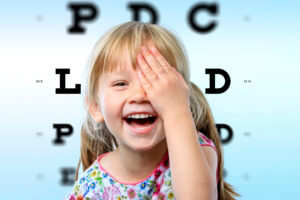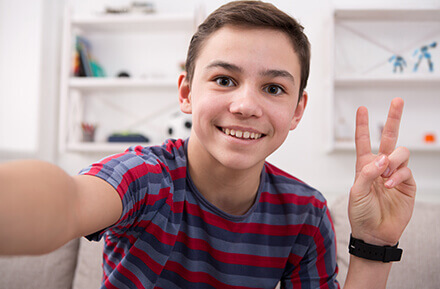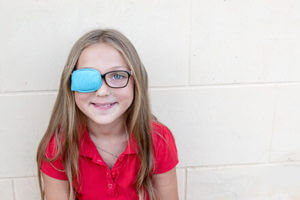Vision Therapy
Overview
 We partner with Bluestem Vision Concepts to provide Vision Therapy services at our facility. Please be advised that Bluestem Vision Concepts does not participate with any insuance plans. Fees for services rendered by Bluestem are due the day of service.
We partner with Bluestem Vision Concepts to provide Vision Therapy services at our facility. Please be advised that Bluestem Vision Concepts does not participate with any insuance plans. Fees for services rendered by Bluestem are due the day of service.
We work with many kids who are frustrated with their learning. Many of these children were bright and eager to learn, yet unable to process the information presented to them at school and fall more and more behind each school year. As school years pass they become less interested in school and may develop behavior problems.
In addition to children with learning difficulties we also work with adults who have experienced a concussion or traumatic brain injury.
We have traditionally worked primarily with home vision therapy, meaning the parents and child (or the adult patient) complete therapy procedures at home (5 days a week). They return to our office once a month for a progress report and to update the therapy procedures. Recently we have expanded our vision therapy services to include office-based vision therapy.
Although home vision therapy has been a convenient option for our many patients who drive many miles to see us, office vision therapy offers several advantages:
- One-on-one time with our therapist
- Instruments to assist therapy that are not available for home use.
- Less time with home therapy (often 2 days a week)
- Faster progress
- Assurance that techniques are completed correctly
- Compliance can be monitored
- Most important: a better success!
Success Stories
Zach (written by Zach’s mom)
 I have home schooled Zach since he was 4 years old and reading was a struggle from the beginning. He had difficulty learning his letters, would read words backwards and couldn’t remember words in a sentence that he had just read. It was a very frustrating situation that often lead to tears for both of us. Because reading is so fundamental, Zach did not enjoy much about school. When a colleague of my husband’s suggested trying vision therapy. I made an appointment right away! After only 8 months it has made a huge improvement in Zach’s reading that he actually likes school (including reading). Thanks so much! – Carol
I have home schooled Zach since he was 4 years old and reading was a struggle from the beginning. He had difficulty learning his letters, would read words backwards and couldn’t remember words in a sentence that he had just read. It was a very frustrating situation that often lead to tears for both of us. Because reading is so fundamental, Zach did not enjoy much about school. When a colleague of my husband’s suggested trying vision therapy. I made an appointment right away! After only 8 months it has made a huge improvement in Zach’s reading that he actually likes school (including reading). Thanks so much! – Carol
Ken (written by Ken’s mom)
 This is a very brief attempt to explain how behavioral optometry has helped our fourteen-year old son. When our son started school at 5 1/2 years, he was a bright, happy child with great willingness to learn. He was physically coordinated, made friends easily, and was well behaved. Toward the end of the school year, the kindergarten teacher said that she couldn’t put her finger on it, but she thought Ken might be having a little difficulty, even though he was trying his best. She then said she hoped he didn’t “fall through the cracks” and passed him on to first grade.
This is a very brief attempt to explain how behavioral optometry has helped our fourteen-year old son. When our son started school at 5 1/2 years, he was a bright, happy child with great willingness to learn. He was physically coordinated, made friends easily, and was well behaved. Toward the end of the school year, the kindergarten teacher said that she couldn’t put her finger on it, but she thought Ken might be having a little difficulty, even though he was trying his best. She then said she hoped he didn’t “fall through the cracks” and passed him on to first grade.
In first grade he was placed in the reading group that needed a “little help”. He was always a bit quiet and shy, and unable to express if he didn’t understand a concept. One day the teacher took me aside and said she was concerned because in a self esteem quiz he answered “no” to the question, “Do you have a friend in this class?” When we asked him about it, he replied, “they’re all my friends!” Aha! We thought, it was a comprehension problem.
The second grade teacher thought that we didn’t give him enough attention. Somehow it was our fault that he didn’t learn as fast as the others. She had taught his sister three years before; evidently we were better parents to her because there was about an eighty point spread between the siblings’ Iowa Basic test scores. But she passed him onto third grade.
It was during this grade that Ken had daily tummy aches. He also developed audible and facial tics. I had him into the family doctor several times. Since Ken’s little brother had been diagnosed with Duchenne Muscular Dystrophy the summer before, the doctor said it was common for siblings to develop vague symptoms, and if we just didn’t make a big deal out of it, it would go away. I asked the teacher if he thought Ken had an attention problem, and the teacher responded, “He doesn’t have an attention problem, he’s lazy and has low motivation!” He then held up a map with detail far beyond what the other kids produced. He said this is what our son was capable of. He told us that he would pound on Ken’s desk with a thud to get him to focus. Well by this time, we were sure that we were failures as parents and his genius older sister was a fluke of nature.
Then in fourth grade he had a teacher with forty years experience. She knew Ken tried hard but that sometimes she could tell she would “lose” him. Also, it was unusual for a fourth grader to spend three hours a night on homework. At the time, I didn’t realize that he understood a concept only after he HEARD us explain it. In the spring we had him evaluated by a psychologist who specializes in learning problems. After exhaustive testing (which did not include a vision exam) it was determined that Ken at ADD without the hyperactivity component. His dad also had similar problems in school but has done fine in life. We were just glad to hear a label given to what was wrong. The solution to Ken’s problem, according to the psychologist, was to either give him Ritalin, or to home school. We chose to home school.
With home schooling, Ken’s scores improved to average for his age, however it has required one-on-one teaching for several hours a day. It was because of this that I attended a seminar of struggling students at a large home schooling convention. One of the speakers was a vision therapist. She explained that vision was the brain’s ability to interpret what the eyes take in. Among the symptoms of vision difficulties that I recall her discussing was: 1) a disparity between intelligence and reading level 2) a reluctance to read anything (for pleasure or school) 3) (the biggest tip off to me) while student reads out loud, he starts out smoothly then has increasing difficulty.
This is the history we brought to your office. We are quite pleased with your professional assessment and prescribed therapy for our son. In the last seven months, his reading level, actual time spent reading, and attention to school work have improved significantly. THANK YOU! We will try to get the word out to families with similar situations. – Jill
Dylan (written by Dylan’s mom)
 My 7-yr old son, Dylan, was a struggling reader. He could sound out words but he wasn’t very fluent. He would read one or two pages and want to quit or have someone else read it to him. He would often squint while reading. Reading was a chore for him.
My 7-yr old son, Dylan, was a struggling reader. He could sound out words but he wasn’t very fluent. He would read one or two pages and want to quit or have someone else read it to him. He would often squint while reading. Reading was a chore for him.
Dylan passed all of his regular eye exams but we felt there must be more that we could do. I visited about vision therapy with a co-worker and decided to bring him to see Dr. Smith. After 6 months of vision therapy and glasses for reading and school work, Dylan’s confidence and ability as a reader have sky-rocketed! His reading scores went up 29 points on a standardized test given in 2nd grade. His fluency and comprehension have improved beyond belief! And best of all, Dylan now loves to read! – Julie
Learning Difficulties
 “It is estimated that 80% of children with a learning disability have an undiagnosed vision problem.” –Vision Council of America
“It is estimated that 80% of children with a learning disability have an undiagnosed vision problem.” –Vision Council of America
- Does your child seem bright, but struggle with reading?
- Is he frustrated with school (as are you)?
- Does he/she tire quickly with homework – come home exhausted from school?
- Do you notice letter or word reversals?
- When your child reads, is a marker or finger necessary to help him or her keep his or her place?
If so, vision is a likely cause.
When vision problems go undetected, children almost invariably have trouble reading and doing their school work. They often display fatigue, fidgeting, and frustration in the classroom – traits that can lead to a misdiagnosis of dyslexia, ADD, or other learning disabilities. During the past three decades we have helped hundreds of students to better grades, better attitude, increased self-esteem and overall improved school performance. Behavioral optometry is often the answer for children who are having difficulty in school.
Here are some initial things you should look for:
- Seems bright, but struggles with reading or math.
- Fatigues quickly with any desk work: reading, math or writing.
- Reverses letters (p for q, d for b) or words (was for saw, on for no).
- Skips and rereads lines, or uses a finger or marker to keep place.
- Older students may be aware of words jumping around or any near work blurring.
- Poor speller when not on a spelling test.
- “Antsy” when required to do homework or sit for any extended time.
- Medication makes the teacher happier, but really hasn’t improved school performance.
- Labeled as LD, ADHD, or ADD.
We all know that vision is the single most important component of learning. According to the American Public Health Association, “twenty-five percent of students in grades K through 6 have visual problems that are serious enough to impede learning.” How efficiently we use our visual system is a key to efficient learning. Behavioral optometry is concerned with this efficiency. It is well established that refractive conditions (“nearsighted”) or clear sight (“20/20”) are not critically important for learning. Most of the children we see for academic concerns do well on a conventional exam. They have passed their school screenings; they often have even passed a full eye exam by another practitioner. But what has not been evaluated is how efficiently they visually perform! There are several key visual functions that are important for your youngster’s school performance.
The Key Skills Are:
- Eye Movement: pursuits (tracking) and saccades (point to point)
- Convergence: the two eyes working together at near
- Binocular Vision: the two eyes teaming together
- Focusing Facility: the ability to shift clear vision from one distance to another
- Focusing Accuracy: focusing at the exact distance you are looking at
- Fixation: aiming your eyes precisely and accurately at the word you are looking at
- Depth Perception: seeing in”3-D”
How Our Examination Is Different
Unfortunately, parents and educators often incorrectly assume that if a child passes a school vision screening, there is no vision problem. However, school vision screenings often only test for visual acuity.
Our Optometrists have the skills, the background and the experience to talk with you and your child about his or her school work. We know what questions to ask. We know how important medical history is. Most importantly, we take the time necessary to thoroughly investigate your child’s vision in the areas necessary for school performance.
Yes, we will do the routine examination. We will do a complete eye health evaluation. Our Optometrists also check for nearsightedness, farsightedness and eye alignment. Of the hundreds and hundreds of children we work with for academic concerns, over 95% do well on the conventional eye examination. They are rarely nearsighted, they almost always see 20/20 and only infrequently do they have trouble with eye-alignment. But they still have trouble in school.
Vision is a complex process that involves over twenty visual abilities and more than 65% of all the pathways to the brain. One in four children has an undiagnosed vision problem which can interfere with learning. Yet, it is important to note that these children frequently do not report symptoms because they think everyone else sees the same way they do.
If we find a problem in the vision area, the most important thing is”WHAT CAN WE DO ABOUT IT?”!! Our Optometrists typically recommend two modes of treatment: a pair of reading glasses to relax the focusing strain that nearly all these students experience with desk work, and a vision therapy program to improve the balance of your son or daughter’s visual skills. VT is ideally done in an office setting. This typically means a one hour visit, once a week for several weeks (remember, it took several years for your child to develop the bad visual habits he has, it will take several weeks for us to teach him correctly). If office VT is not an option we can set up a”home VT” program for you to work with your child at home.
One more note: although most of the behavioral work we do is with children with academic concerns we also work with other areas: strabismus (“cross-eyed”), amblyopia (one eye not seeing as clearly as the other) sports vision (Our Optometrists can improve your golf score) and any area of visual discomfort. We even help adults!
Feel free to check for more information at COVD (College of Optometrist in Vision Development) and OEP (Optometric Extension Program).
Strabismus
 Strabismus also called crossed eyes is the inability to point both eyes in the same direction at the same time. While eye muscle surgery can sometimes straighten the eyes, a program of Vision Therapy is a better option as our goal is to restore full visual function.
Strabismus also called crossed eyes is the inability to point both eyes in the same direction at the same time. While eye muscle surgery can sometimes straighten the eyes, a program of Vision Therapy is a better option as our goal is to restore full visual function.
Amblyopia
 Amblyopia or “lazy eye” is a condition where one eye sees poorly even with eyeglasses or contact lenses. A Vision Therapy program can help to equalize the vision in both eyes, improve eye coordination, and restore clear single vision.
Amblyopia or “lazy eye” is a condition where one eye sees poorly even with eyeglasses or contact lenses. A Vision Therapy program can help to equalize the vision in both eyes, improve eye coordination, and restore clear single vision.
Strokes, Brain Injuries, and Concussions
 Vision problems are among the most common problems associated with acquired brain injuries. Causes of brain injury can include trauma, auto accidents, suffocation, drug reaction, and strokes. Initially, symptoms may be subtle but often become more of a concern with time. Specific problems can include poor memory, disorientation, loss of reading skills or poor word recall.
Vision problems are among the most common problems associated with acquired brain injuries. Causes of brain injury can include trauma, auto accidents, suffocation, drug reaction, and strokes. Initially, symptoms may be subtle but often become more of a concern with time. Specific problems can include poor memory, disorientation, loss of reading skills or poor word recall.
Sports Vision
 Vision, just like speed and strength, is an important component in how well you play your sport! Without good dynamic visual acuity, tracking and peripheral vision you are going to have difficulty with fast moving objects while playing your sport.
Vision, just like speed and strength, is an important component in how well you play your sport! Without good dynamic visual acuity, tracking and peripheral vision you are going to have difficulty with fast moving objects while playing your sport.









